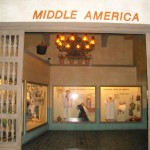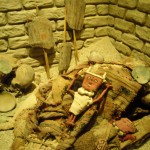Tue 8 Dec 2009
Judith Lizmeth Soliz Cortez, known as Elize to her friends and family, turned fifteen years old on Saturday, November 28, 2009. I had the pleasure of attending because she is my step-father’s cousin. In her Mexican culture it is common for a fifteen year old girl to celebrate what is called a quincenera. A quincenera is an extravagant party to celebrate a girl entering womanhood. They are very similar to a sweet sixteen in American culture.
Before the party, all guests attended a special mass in honor of Elize. She was dressed in a very beautiful, white ball gown and had her hair done. During mass the family prayed for Elize and it continued on like a typical Catholic mass. After mass, the family left in a limousine to the reception hall. Elize was standing at the door to greet all the guests to take a special picture with her and to have them sign the Guest Book. Once we were finished with pictures, all guests ate a large meal with chicken and red mole sauce, Mexican rice, and beans. My step-father explained to me that this is the typical meal at a quincenera. Both alcoholic and nonalcoholic Pina Coladas were the drink of choice at this particular party.
The tables we were seated at were decorated with recuerdos which the guests were given to take home. Usually recuerdos consist of little hats, like Elize had, or stuffed animals, dolls, or figurines. Sometimes they even give out salt and pepper shakers. Another gift given to the guests were ribbons from her doll. We each wore them as corsages.
Elize was given a crown, which is very common for a quincenera. She, then, participated in a special dance. First, she danced with her chambelanes, which are her escorts for the party. They danced to upbeat, cumbian music. Next, she danced with her mother and father. Then, all the padrinos and madrinas were invited to dance. Padrinos and madrinas are the people who help pay for the party. My family helped pay for the cake.
After that, she was given her last toy which was a large doll. Then, the band played Feliz Cumpleanos (Happy Birthday) and cut the cake. The cake resembled a wedding cake. It was a white cake with strawberry filling and had multiple tiers. Once the cake was cut, everybody loosened up and enjoyed some drinks and dancing.
I believe this event ties into our class because I got to see a Spanish Catholic mass. I learned that Spanish mass is very similar to the mass performed in my church. Also, I was able to hear the Mexican music and learn which genre it came from. My step-father explained to me that it was Cumbian music. Another topic we covered in class was dance. Although the dancing was very different from the Capoeira, I believe it was beneficial for me to observe. There was not one Mexican person that did not know how to dance. I found this very interesting.
After leaving this party I was curious if there was a special party for men to celebrate their transformation into manhood. My parents explained that there was not. I truly enjoyed myself at this party. I think that all people should attend one to see the great lengths they go to. It also showed the closeness of the Mexican families. Overall, I was very glad to be there and I have learned a lot.






 Nachito Herrera is a Cuban pianist quickly gaining recognition in the United States. Originally from Havana Cuba, he has become a familiar face at the Dakota Jazz Club in Minneapolis, MN since moving to St. Paul a few years ago.
Nachito Herrera is a Cuban pianist quickly gaining recognition in the United States. Originally from Havana Cuba, he has become a familiar face at the Dakota Jazz Club in Minneapolis, MN since moving to St. Paul a few years ago.




![Photo-0004[1]](http://blogs.uww.edu/introtolatinamerica/files/2009/12/Photo-00041-300x225.jpg)
![Photo-0011[1]](http://blogs.uww.edu/introtolatinamerica/files/2009/12/Photo-00111-300x225.jpg)
![Photo-0014[1]](http://blogs.uww.edu/introtolatinamerica/files/2009/12/Photo-00141-300x225.jpg)
![Photo-0015[1]](http://blogs.uww.edu/introtolatinamerica/files/2009/12/Photo-00151-300x225.jpg)
![Photo-0017[1]](http://blogs.uww.edu/introtolatinamerica/files/2009/12/Photo-00171-300x225.jpg)
![Photo-0018[1]](http://blogs.uww.edu/introtolatinamerica/files/2009/12/Photo-00181-300x225.jpg)
![Photo-0022[1]](http://blogs.uww.edu/introtolatinamerica/files/2009/12/Photo-00221-300x225.jpg)
![Photo-0020[1]](http://blogs.uww.edu/introtolatinamerica/files/2009/12/Photo-00201-300x225.jpg)